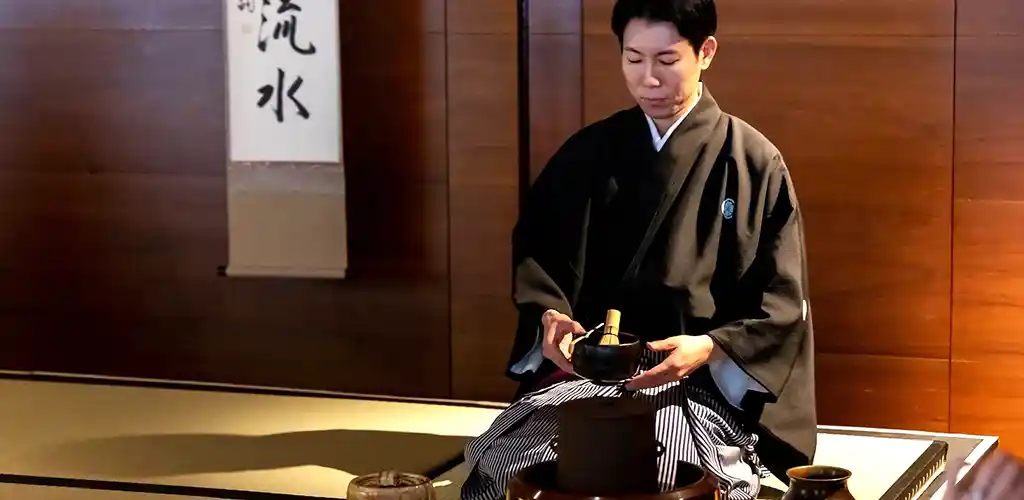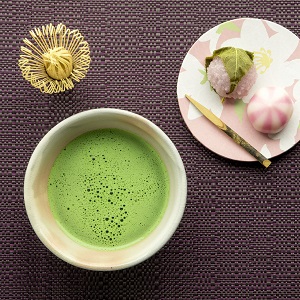Japanese Tea Ceremony
In Japan, the tea ceremony is a composite art where the sense of beauty, space, etiquette, and the spirit of hospitality coalesce and is based on four principles of harmony, respect, purity and tranquility. Experience the sublime “Way of Tea” during a private traditional tea ceremony lead by a tea master in a traditional machiya (wooden townhouse) we will arrange during your stay in Kyoto. This tranquil ancient ritual is deeply rooted in history and rich with symbolism—one of the most insightful and pleasant experiences you can have during your travel in Japan.
JAPAN'S GREEN TEA OBSSESSION
Japanese monks brought tea back to Japan after traveling to China in the 6th century. Tea later became valued for its medicinal qualities and began being imported from China in the 8th century. However, ritualized tea drinking was only first practiced in Japan during the Kamakura period (1192–1333) by Zen monks, who drank tea to keep awake during long sessions of meditation. Nobility later took to drinking tea at grand parties while Murata Shuko (1422–1502) developed the custom’s initial spiritual aspects and ritual in Kyoto. The "way of tea" was soon embraced by the samurai.
The most famous proponent of the tea ceremony was Sen Rikyū, an aesthete at the 16th-century court of the military dictator Toyotomi Hideyoshi, who codified the ceremony into a style known as wabi-cha which emphasizes simplicity. Rikyū also established the four principles of Chanoyu mentioned above (wa kei sei jaku), which still enjoys popularity in Japan. The preference of the wabi-cha tea masters for simple, seemingly rustic objects for use in the tea ceremony led to the production of tea utensils in this simple style most notably the famous pottery used for pots, bowls and cups, known as raku ware. Since then, tea has become a quintessential part of Japanese culture and sipped everywhere, from Tokyo’s hip cafés to elaborate tea ceremonies in Kyoto's temple gardens. Wazuka, near Kyoto, is landscapes of undulating tea bushes and where the country's finest and most prized-tea tea, Ujicha, is from.

THE TEA CEREMONY
The most important aspect of the Japanese tea ceremony is the setting. The chashitsu, or tea house or tea room, must provides a serene atmosphere, critical for the tranquil nature of ceremony itself. The term chashitsu includes free-standing architectural buildings designed for tea ceremony and specific rooms intended for tea ceremony, and its surrounding facilities, including the garden path leading to it and pond, such as in Shakusui below.

Your tea practitioner, or host, will be familiar not only with preparing tea, but also the production and types of tea and associated components, including kimono, calligraphy, flower arranging, ceramics, incense and familiar with a wide range of other disciplines and traditional arts in addition to their school's tea practices. The study of tea ceremony takes many years and often lasts a lifetime and there are tea ceremony schools—the main ones, Urasenke and Omotesenke, have their headquarters located in Kyoto
The point of the chaji (ritual), in which a light meal and whisked powdered matcha (tea) are served by a host to a few invited guests, is founded in the samurai ideal “one lifetime, one meeting” (ichigo, ichie). It is a moment to be treasured. A host presenting a decorated bowl of matcha to one of their guests.

The tea ceremony emphasizes the following principles decreed by Rikyū in the 16th century: harmony between the guests and the implements used; respect, not only among the participants, but also for the utensils; cleanliness which is derived from Shintō practices, requiring participants to wash their hands and rinse their mouths as symbolic gestures of cleansing before entering the cha-shitsu; and tranquility, which is imparted through long and caring use of each component of the tea ceremony.
HOW TO TAKE TEA
Quest for the perfect matcha experience

The tea ceremony is a well-orchestrated series of ritualized action. First, respect requires tying any long hair up into a bun and removing any jewelry. Note that perfume or cologne should not be worn to the ceremony. Then don white tabi socks and iromuji, a traditional kimono of a single solid color, without large patterns or elaborate designs. After meeting your fellow guests, if any, walk mindfully through the grounds around the teahouse, performing ablutions en route. Remove any sandals or shoes at the teahouse portal and once inside the tea room, bow and then compliment the features of the room and the quality of the utensils, but afterwards remain silent for the duration of the ceremony.
Observe calmly and silently as utensils are cleaned and tea is being prepared. After being served tea, only after bowing can you consume the wagashi (sweets) and tea. To drink matcha, sit seize (kneeling) on the tatami mat, bow to your host when offered a steaming bowl, then hold the tea with your right hand, and place it in the palm of your left. Turn the bowl clockwise about 90 degrees, raise it with both hands, and then empty the matcha in three gulps. During the one to three hour-long private ceremony, enjoy the pleasant setting of the tea house, surrounding nature, and calming, ritualized engagement with your host. Along with witnessing the choreographic practice of predefined movements and aesthetics in preparing and serving of green tea (matcha), enjoy traditional Japanese dry sweets (higashi) and moist sweets (omogashi), that are served with the intent to balance the bitter taste of the green tea.
Not being Japanese, our hostess will kindly provide additional details about the complex etiquette, principles, and facets of the ceremony after our tea is consumed. We may then also inquire about the various implements and other questions.

